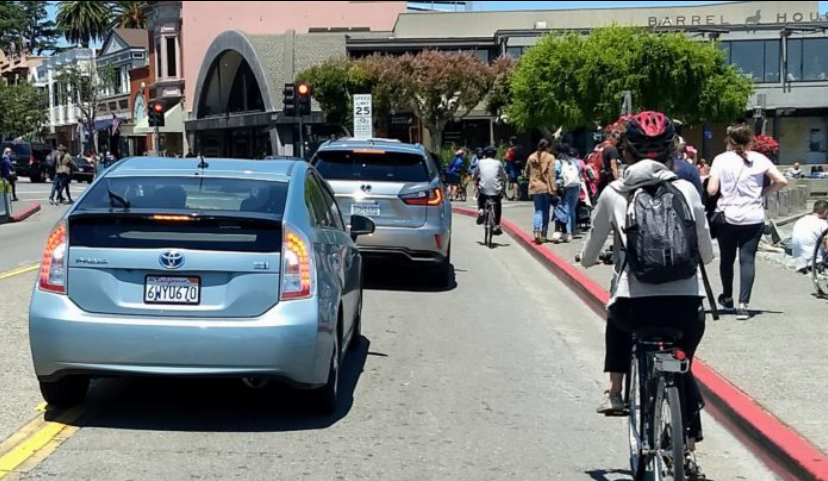Note: GJEL Accident Attorneys regularly sponsors coverage on Streetsblog San Francisco and Streetsblog California. Unless noted in the story, GJEL Accident Attorneys is not consulted for the content or editorial direction of the sponsored content.
The city of Sausalito received a $70,000 Metropolitan Transportation Commission (MTC) grant to study putting bike lanes on a half mile of Bridgeway Street from 2nd and Richardson to the ferry terminal. Right now the street is a hairy mix of confused tourists in cars and on bikes conflicting with commuters and pedestrians. Currently, it has no bike facilities whatsoever (unless one counts sharrows, which Streetsblog does not).

In the before times, the last time a count was made, some “2,000 people a day biked on this section,” explained the Marin County Bicycle Coalition’s Warren Wells. “It’s a very busy stretch of road that is not an all-ages-and-abilities facility.”
That’s putting it mildly. The stretch of Bridgeway in question gets a report of one serious injury crash per year involving a pedestrian or a cyclist–that’s using data from the Transportation Injury Mapping System at U.C. Berkeley. Bridgeway is not safe as it’s currently configured.

The MCBC has been advocating for improvements since at least 2018. With the MTC grant in hand, the next step was for the Sausalito City Council at its regular meeting on Tuesday to approve some $60,000 from the budget to pay the balance on a contract for a detailed study on upgrading Bridgeway to be safer and more accommodating for all users. That could be accomplished by eliminating the center turn lane and carving out at least some, partially protected space for bikes.
However, as this is Sausalito, the BANANAs were already out in force to resist any such possibilities.
Councilmember Joan Cox pulled the item from the consent calendar, the list of non-controversial decisions that a city council will usually rubber stamp. “We received literally dozens of letters and this is a highly controversial item,” said Cox at the meeting. “The path towards finding consensus might be tortuous.”
Indeed, it might be–especially if a city councilperson immediately makes it so. Reminder: they were not being asked to authorize funds to build anything, just to study what they might build to make things safer.
“This should not have been taken off the consent calendar,” said Wilderness Trail Bike/Transportation Alternatives for Marin representative Matthew Hartzell during public comment. He also cautioned that if Sausalito doesn’t study options, regional authorities won’t take their future grant applications seriously.
But that didn’t stop people from calling in to complain about a bike lane project that doesn’t exist. One caller said it will eliminate necessary loading. Another said merchants are opposed to this, whatever “this” might be.
“We are not asking the council to commit to a design,” explained Wells, also during the meeting. He said they just need to fund a study so professional transportation planners can look at options and the implications of each one.
Meanwhile, Adrian Brinton, who first brought the meeting to Streetsblog’s attention, lives in Sausalito and cycles to his job in San Francisco three days a week. He also regularly walks on Bridgeway. “From a bike standpoint, the biggest issues are the volume and quantity of tourists and novices taking in the views, and drivers who aren’t paying attention, looking for parking,” he told Streetsblog. “They pull U-turns right in the middle.”
He said he hopes the city will consider a two-way protected bike lane on the water side of the street–if the study ever gets funded and started. Wells, meanwhile, said given the resistance to losing parking and the complexities of transitioning in and out of a two-way that would only run half a mile, getting a one-way protected bike lane in the northbound direction may be the best they can hope for at this point.
But it’s unclear if these options or any others will ever get considered. After two hours of discussion, the council decided to continue (essentially to delay) the conversation about whether or not to study bike lanes to some future date.






